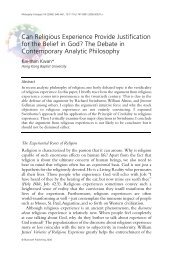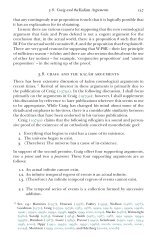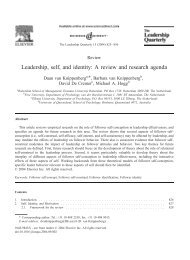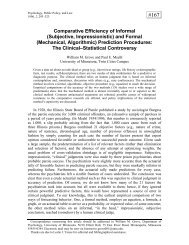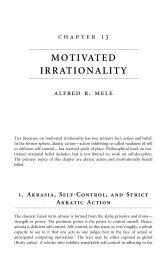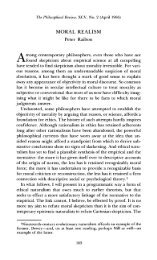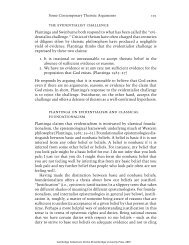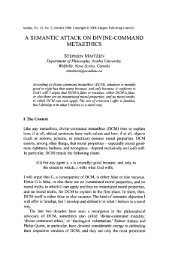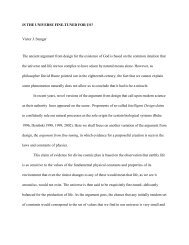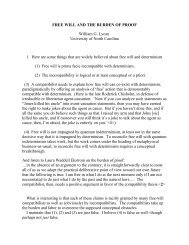Building blocks for artificial moral agents
Building blocks for artificial moral agents
Building blocks for artificial moral agents
Create successful ePaper yourself
Turn your PDF publications into a flip-book with our unique Google optimized e-Paper software.
<strong>Building</strong> <strong>blocks</strong> <strong>for</strong> <strong>artificial</strong> <strong>moral</strong> <strong>agents</strong><br />
Vincent Wiegel 1<br />
1 Faculty of Policy, Technology and Management, Delft University of Technology<br />
v.wiegel@tbm.tudelft.nl<br />
Abstract<br />
Constructing <strong>artificial</strong> <strong>moral</strong> <strong>agents</strong> serves at least two<br />
purposes: one, better understanding of <strong>moral</strong> reasoning, and,<br />
two, increasing our trust and confidence in creating<br />
autonomous <strong>agents</strong> acting on our behalf. When constructing<br />
<strong>agents</strong> we must identify what kind of agent we are trying to<br />
implement acknowledging still severe restrictions in both<br />
our understanding of <strong>moral</strong> reasoning and technological<br />
capabilities. In constructing <strong>agents</strong>, as part of the SophoLab<br />
project, we adopt a set of requirements and design<br />
principles. As building <strong>blocks</strong> the belief-desire-intention<br />
model is used along with the deontic-epistemic-action logic<br />
framework as modeling and specification languages.<br />
Implementation in executable software is done using the<br />
JACK agent language. Attempts at constructing <strong>agents</strong> and<br />
actual experiments provide some first encouraging results<br />
but also point at the large hurdles still to be taken.<br />
Drivers <strong>for</strong> <strong>artificial</strong> <strong>moral</strong> <strong>agents</strong> research<br />
There are at least two perspectives on the combination of<br />
<strong>artificial</strong> <strong>agents</strong> and ethics that make it a very interesting<br />
combination. One, attempting to create <strong>artificial</strong> <strong>agents</strong><br />
with <strong>moral</strong> reasoning capabilities challenges our<br />
understanding of <strong>moral</strong>ity and <strong>moral</strong> reasoning to its<br />
utmost. It requires attention to the general structure and<br />
architecture, as well as to the little details. As the computer<br />
is a relentless component that will not function until<br />
completely instructed it pushes us <strong>moral</strong> philosophers to<br />
explicate everything we know. It also challenges our <strong>for</strong>mal<br />
apparatus to express our knowledge such that is <strong>for</strong>mal<br />
enough <strong>for</strong> software engineers to be understood. Two, with<br />
the advancement of technological development artifacts<br />
play increasingly important roles in our lives. They do not<br />
only contain in<strong>for</strong>mation about us, they start to act on our<br />
behalves. With the increasing autonomy comes an<br />
increased need to ensure that their behavior is in line with<br />
what we expect from them. We want to ensure that no<br />
abuse is made when opportunity offers, no harm is done to<br />
others, etc. Besides this negative, constraining aspect there<br />
is also a positive aspect. If we want to develop machines<br />
that can act to help us, <strong>for</strong> example in circumstances where<br />
we cannot come because it is too dangerous, they will need<br />
all the reasoning power we can give them including <strong>moral</strong><br />
reasoning.<br />
When attempting to construct <strong>artificial</strong> <strong>moral</strong> <strong>agents</strong> we<br />
need to define, at least roughly, what it is that we are<br />
aiming at. Moor proposes a classification of four types of<br />
ethical <strong>agents</strong>: ethical impact <strong>agents</strong>, implicit ethical <strong>agents</strong>,<br />
explicit ethical <strong>agents</strong> and full ethical <strong>agents</strong> (Moor 2006).<br />
Ranging from <strong>agents</strong> that have an impact by their very<br />
existence to full blown, human-like reasoning <strong>agents</strong> that<br />
have consciousness, intentionality and an ability to provide<br />
plausible justifications <strong>for</strong> their actions.<br />
Given our current understanding of <strong>moral</strong> reasoning,<br />
<strong>artificial</strong> intelligence, epistemological devices, etc. the best<br />
we can try to construct are explicit ethical <strong>agents</strong> that can<br />
make some ethical judgments that are not hard-wired into<br />
their make-up and have some ability to provide an account<br />
of how they arrived at their judgment.<br />
In terms of sophistication we are now looking to implement<br />
second generation <strong>moral</strong> <strong>agents</strong>. The first generation<br />
<strong>artificial</strong> <strong>moral</strong> <strong>agents</strong> were ground breaking in that they <strong>for</strong><br />
the first time implemented <strong>moral</strong> decision making (a<br />
paradigmatic example in case Danielson 1992) . They are<br />
limited in their orientation (<strong>moral</strong> issues only), their<br />
internal make-up, and interoperability and interconnectedness.<br />
The current generation will have support <strong>for</strong> <strong>for</strong>ms of<br />
interconnectedness (team work <strong>for</strong> example), be multipurpose<br />
(mixture of <strong>moral</strong> and non-<strong>moral</strong> goals) and still be<br />
very limited in embodiment (mainly electronic) and<br />
epistemology (only strong typed). A next generation will<br />
probably bring physically embodied <strong>agents</strong> with strong<br />
<strong>moral</strong> epistemological capabilities.<br />
Design principles and requirements<br />
In implementing and experimenting with <strong>artificial</strong><br />
constructs we follow a methodology that focusses on the<br />
translation from one environment - theory and application -<br />
to another - the <strong>artificial</strong> setting (Wiegel 2006b). This<br />
translation happens in several steps. Key is that the theory<br />
and application examples are modeled in a (semi)<strong>for</strong>mal<br />
language that is close to the implementation environment.<br />
The requirements that follow from this methodology are<br />
amongst others:<br />
• neutrality - support <strong>for</strong> various (meta-)ethical<br />
theories<br />
• executability<br />
• comprehensibility<br />
• <strong>for</strong>mality<br />
• configurability<br />
• scalability<br />
• extendibility<br />
(see also Dumas et. al., 2002, who come up with a similar<br />
set of requirements <strong>for</strong> <strong>artificial</strong> <strong>agents</strong> geared <strong>for</strong> economic<br />
transactions, and with whom I share kindred approach).<br />
The environments in which <strong>artificial</strong> <strong>moral</strong> <strong>agents</strong> will<br />
operate will not be fully predictable and controlled. And if<br />
we want them to be successful they will have to have the
ability to determine their actions autonomously, that is their<br />
behavior and action repertoire are not predictable (note that<br />
determinism does not imply predictability!). And in time<br />
new abilities will be added onto the existing set<br />
(dynamically). The <strong>agents</strong> will be active in different<br />
application domains and engage in both non-<strong>moral</strong> and<br />
<strong>moral</strong> activities. They will pursue different goals at the<br />
same time, and have to make decisions within limited time<br />
and restricted in<strong>for</strong>mation. The list of requirements<br />
following from these observations are:<br />
• mixed <strong>moral</strong> and on-<strong>moral</strong> goals support<br />
• mixed <strong>moral</strong> and on-<strong>moral</strong> activity support<br />
• bounded rationality, time & resource constraint<br />
• extendibility<br />
This is not an exhaustive list of all requirements, but it does<br />
capture several key ones.<br />
Following from these requirements a set of design<br />
principles can be <strong>for</strong>mulated (from which I omit the<br />
software engineering oriented ones):<br />
• <strong>agents</strong> behave both pro-actively, goal driven and<br />
reactively<br />
• behavior is build from small action components<br />
that can be put to various uses and re-configured<br />
at run-time to <strong>for</strong>m different behavior patterns<br />
• <strong>agents</strong> can decide if and when to update their<br />
in<strong>for</strong>mation base<br />
• <strong>agents</strong> interact with each other and the<br />
environment<br />
These principles are in support of what Korniek and<br />
Uzgalis observed as important characteristics of successful<br />
biological systems, which I feel are directly relevant in this<br />
context (Korniek and Uzgalis 2002:85).<br />
• emergent behavior – not all behavior is specified<br />
upfront<br />
• redundant degrees of freedom – more ways to<br />
achieve a particular goal<br />
• no central director of action<br />
• think local, act local – local scope of control<br />
These are characteristics <strong>agents</strong> should have, and/or display<br />
in order to be able to meet to above requirements.<br />
<strong>Building</strong> <strong>blocks</strong>: modeling & implementation<br />
To model agent behavior the belief-desire-intention model,<br />
BDI-model (Bratman, 1987) provides a good foundation. It<br />
captures both bounded rationality, and the goal oriented<br />
aspect that is required <strong>for</strong> autonomous <strong>agents</strong>. There are<br />
two important elements missing in the BDI-model to make<br />
it suitable <strong>for</strong> modeling <strong>artificial</strong> <strong>moral</strong> <strong>agents</strong>: the deontic<br />
element and the action element. There<strong>for</strong> the BDI-model is<br />
extended through the deontic-epistemic-action logic,<br />
framework, DEAL framework (Van den Hoven and<br />
Lokhorst, 2002). The deontic logic covers the deontic<br />
concepts of 'obligation', 'permission', and '<strong>for</strong>bidden'.<br />
Epistemic logic expresses the things we know and belief.<br />
And the action logic allows us to reason, through the STIT<br />
– see to it that – operator to reason about actions.<br />
Combined we can construct propositions like<br />
• Bi(G(Φ)) → O([i STIT Φ])<br />
meaning if i believes that 'Φ' is <strong>moral</strong>ly good than i should<br />
act in such as way that 'Φ' is brought about<br />
The modal logic in this approach is used as a specification<br />
language rather than as <strong>for</strong>mal logic <strong>for</strong> theorem proving.<br />
My sentiment in this respect is very much that of (Halpern,<br />
2000:1)<br />
“McCarthy want robots to reason with a <strong>for</strong>mal logic.<br />
I'm not sure that is either necessary or desirable.<br />
Humans certainly don't do much reasoning in a <strong>for</strong>mal<br />
logic to help them in deciding how to act; it's not clear<br />
to me that robots need to either. Robots should use<br />
whatever <strong>for</strong>malisms help them deciding. Robots<br />
should use whatever <strong>for</strong>malisms help them make<br />
decisions. I do think logic is a useful tool <strong>for</strong><br />
clarifying subtleties and <strong>for</strong> systems designers to<br />
reason about systems (e.g., <strong>for</strong> robot designers to<br />
reason about robots), but it's not clear to me that it's as<br />
useful <strong>for</strong> the robots themselves.”<br />
Of course, software <strong>agents</strong> and robots do need logic. It is<br />
inconceivable that they reason without logic. But they need<br />
not necessarily have a complete and sound logic system.<br />
Using the BDI and DEAL modeling tools <strong>agents</strong> can be<br />
attributed both <strong>moral</strong> and non-<strong>moral</strong> desires, have beliefs<br />
about what is <strong>moral</strong>ly obligatory or permissible, <strong>for</strong>m<br />
multiple intentions, decide to act on them, and actually<br />
enact them.<br />
The implementation of these models is done using the<br />
JACK agent language (JACK). This abstraction layer on<br />
top of the Java programming language provides support <strong>for</strong><br />
multi-agent systems, based on the BDI-model. It provides<br />
components <strong>for</strong> <strong>agents</strong>, team, modalities of belief, desire<br />
and intention. Plans are sequences of actions that provide<br />
low level components <strong>for</strong> behavior. Plans are connected at<br />
run-time to provide complex behavior. To facilitate metalevel<br />
reasoning there are various mechanisms ranging from<br />
hard-wired, instantaneous choice to explicit reasoning<br />
about options and preferences. Beliefs are implemented as<br />
n-tuples (first-order relational models) that support both<br />
open-world and closed-world semantics. Plans can be<br />
reconsidered based on new desires (events), and new<br />
in<strong>for</strong>mation becoming available. Plans can be linked to<br />
beliefs using logic variables <strong>for</strong> which <strong>agents</strong> can find<br />
multiple bindings. An intricate mechanism that allows to<br />
cater <strong>for</strong> multiple instances of an objective.<br />
Some results<br />
These building <strong>blocks</strong> proved to be a powerful basis to<br />
capture, model and implement aspects of <strong>moral</strong> agency,<br />
though still a great deal needs to be done (Wiegel 2006a.<br />
Below I list some examples of the (support <strong>for</strong>) insights<br />
gained.
1) Negative <strong>moral</strong> commands are different in nature from<br />
the way we talk about them. 'Thou shall not...' is a general<br />
<strong>for</strong>m of <strong>moral</strong> command telling you what not to do. Trying<br />
to implement such obligations proved rather hard. The<br />
reason is that these commands are in fact not about acts as<br />
we talk about about them: do not kill, do not lie, etc. There<br />
are many ways (in fact infinite) in which one can kill, and<br />
identifying each of them is impossible. These <strong>moral</strong><br />
commands are actually about classes of action that are<br />
characterized by their outcome, e.g. bringing about a state<br />
of affairs in which someone does not have a beating hart,<br />
with all the qualifiers about intentionality, etc. This<br />
observation implies that <strong>agents</strong> must have an explicit<br />
conception (right or wrong) about the outcomes of their<br />
actions, and the ability to classify them accordingly.<br />
2) Morality must act as both restraint and goal-director.<br />
Moral reasoning in <strong>artificial</strong> <strong>agents</strong> much function within a<br />
large context. An <strong>artificial</strong> <strong>moral</strong> agent in its own right<br />
does not have much practical relevance when it comes to<br />
application. An agent can have as one of its goals or desires<br />
to be a <strong>moral</strong> agent, but never as its only or primary goal.<br />
So the implementation of <strong>moral</strong> reasoning capability must<br />
always be in the context of some application in which it<br />
acts as a constraint on the other goals and action.<br />
3) Moral decision making or decision making with <strong>moral</strong><br />
constraints must take various restricting factors into<br />
account. One, an agent is open to permanent in<strong>for</strong>mation<br />
feeds. It must be able to decide on ignoring that<br />
in<strong>for</strong>mation or taking it into account. Two, once goals have<br />
been set, these goals must have a certain stickiness.<br />
Permanent goal revision would have a paralyzing effect on<br />
an agent and possibly prevent decision making. Three,<br />
different situations require different decision-making<br />
mechanisms. In some situations elaborate fact finding and<br />
deliberation are possible, in other the decision must be<br />
instantaneous.<br />
All these three restrictions refer to resource boundedness<br />
and the time consuming dimension of decision making. To<br />
cater <strong>for</strong> these the BDI-model provides a good basis. The<br />
software implementation offers three decision making, or<br />
meta-level reasoning mechanisms: hardwired, ordinal and<br />
cardinal ranking and explicit reasoning.<br />
4) Moral epistemology will prove to be the biggest<br />
challenge <strong>for</strong> the implementation of <strong>artificial</strong> <strong>moral</strong> <strong>agents</strong>.<br />
(Meta-)ethical theories make strong epistemological claims.<br />
E.g. if <strong>moral</strong> qualities are supervenient on natural qualities<br />
how does an agent perceive these natural qualities and<br />
deduce the <strong>moral</strong> dimension from them? If <strong>moral</strong> qualities<br />
are non-reducible how does an agent intuit or perceive<br />
them? How does an agent come to approve of something,<br />
and hence call it <strong>moral</strong>ly good?<br />
These are very hard questions <strong>for</strong> which no clear answers<br />
are available that can be <strong>for</strong>malized. Moral epistemology of<br />
<strong>artificial</strong> <strong>agents</strong> will have to be strong typed <strong>for</strong> the near<br />
future. This means that perception, events, facts, etc. have<br />
to be typed at design-time. This means <strong>for</strong> example that<br />
events will need to have an attribute identifying its type,<br />
which then allows the agent to interpret it.<br />
5) Walk-of-life scenario testing is a good way to test the<br />
<strong>agents</strong>. To better understand the above findings and to test<br />
<strong>artificial</strong> <strong>moral</strong> <strong>agents</strong> a Walk-of-life scenario provides a<br />
good tool. It details 'a day in the life of' <strong>for</strong> an agent in<br />
which it pursues various goals and is confronted with<br />
different events that require various <strong>for</strong>m of deliberation.<br />
With all the promising results a note of reserve is called<br />
<strong>for</strong>. With Wooldridge, writing on his logic <strong>for</strong> rational<br />
<strong>agents</strong>, I would like to say (Wooldridge, 2000:91)<br />
“Belief, desire and intention are in reality far too<br />
subtle, intricate and fuzzy to be captured completely in<br />
a logic [...] if such a theory was our goal, then the<br />
<strong>for</strong>malism would fail to satisfy it. However, the logic<br />
is emphatically not intended to serve as such a theory.<br />
Indeed, it seems that any theory which did fully<br />
capture all nuances of belief, desire and intention in<br />
humans would be of curiosity value only: it would in<br />
all likelihood be too complex and involved to be of<br />
much use <strong>for</strong> anything, let alone <strong>for</strong> building <strong>artificial</strong><br />
<strong>agents</strong>.”<br />
This goes <strong>for</strong> logic, and <strong>for</strong> any other means to capture the<br />
aspects of <strong>moral</strong> reasoning. With our current understanding<br />
of <strong>moral</strong> reasoning, the challenges of <strong>moral</strong> epistemology<br />
and the state of technology development (far and<br />
impressive though it is, still falling short by a long way) we<br />
will have to settle <strong>for</strong> limited <strong>artificial</strong> <strong>moral</strong> <strong>agents</strong>. The<br />
explicit ethical agent is an ambitious goal though within the<br />
realm of the possible in our personal <strong>for</strong>eseeable future.<br />
References<br />
Agent Oriented Software Pty. Ltd, JACK, www.<strong>agents</strong>oftware.com.au<br />
Bratman, M.E., 1987. Intention, Plans and Practical<br />
Reasoning, Harvard University Press, Cambridge<br />
Danielson, P., 1992. Artificial Morality, Routledge,<br />
London<br />
Governatori, 2002. A Formal Approach to Negotiating<br />
Agents Development, in Electronic Commerce Research<br />
and Applications, 1 no. 2<br />
Halpern, J., 2000. On the adequacy of model logic, II,<br />
Eletronic News Journal on reasoning about action and<br />
change
Hoven, M.J. van den, Lokhorst, G.J., 2002. Deontic Logic<br />
and Computer Supported Computer Ethics in<br />
Cyberphilosophy, Bynum et. al. (eds)<br />
Moor, J.H., 2006. The nature, importance, and difficulty of<br />
machine ethics (IEEE <strong>for</strong>thcoming)<br />
Wiegel, V. et. al., 2006a. Privacy, deontic epistemic action<br />
logic and software <strong>agents</strong>, in Ethics and in<strong>for</strong>mation<br />
technology <strong>for</strong>thcoming<br />
Wiegel, V., 2006b. SophoLab (<strong>for</strong>thcoming), in Ethics and<br />
In<strong>for</strong>mation Technology<br />
Wooldridge, M., 2000. Reasoning about Rational Agents,<br />
MIT Press, Cambridge



